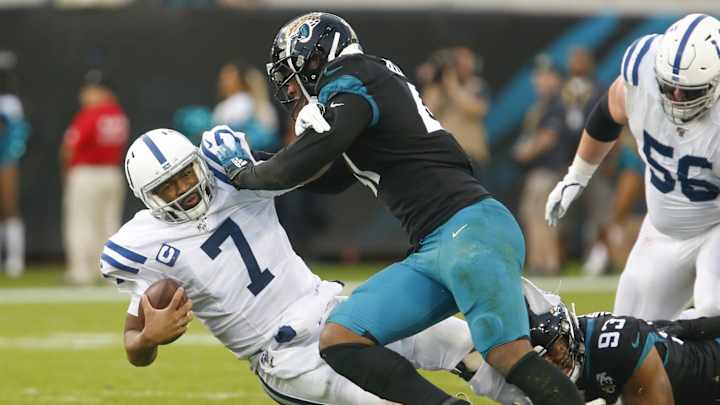Who Were the Jaguars’ Biggest Defensive Playmakers Last Season?

Last season, the Jacksonville Jaguars defense was among the worst in the league, ranking 30th in yards per play allowed. An advanced metric called Expected Points Added (EPA) can be used to determine which individual defenders made the most plays for the Jaguars last season and contributed to or impaired Jacksonville’s defense, and how Jacksonville can move forward on the defensive side of the ball.
EPA analyzes how much any given play is likely to result in points at the end of a drive. For example, a 20-yard gain will generate a positive offensive EPA, and a sack will result in a negative offensive EPA. EPA considers factors like down and distance, field position, and time remaining. ESPN has a more in-depth explanation of EPA.
Playmaking plays are solo tackles, assisted tackles, forced fumbles, fumble recoveries, quarterback hits, pass deflections, interceptions and blocked punt/field goals. Not all of these plays are created equal, as a tackle in the backfield will result in a better defensive EPA than a tackle 10 yards past the line of scrimmage. This difference in value is why it’s important to look at playmaking EPA as opposed to strictly cumulative plays made, as EPA includes context.
Without further ado, here were Jacksonville’s 2019 defensive playmaking leaders, with data from nflscrapR.


The first chart displays the cumulative number of plays made and the playmaking EPA of those plays, as well as a slope line that is the league average of EPA per play made. The second chart distinguishes playmaking EPA by plays made on rushing plays and passing plays. The size of the gray circles represent the number of plays made, and the minimum number of plays made needed to qualify is 10.
A few notes from the charts above and the full collection of data:
- On average, NFL players earn 0.88 EPA per play made, as symbolized by the slope line in the first chart. Quincy Williams had a playmaking EPA of 10.4 on 25 plays made, while the average player would be expected to earn 22.0 EPA on the same amount of plays made, leaving Williams with -11.6 EPA over expected. Williams specifically generated a relatively low playmaking EPA in part because all of his plays made were tackles, which aren’t as valuable as passing plays made like interceptions or quarterback hits because passing is more valuable than running. Meanwhile, Yannick Ngakoue registered a team-high +13.6 EPA over expected, and unsurprisingly the majority of his plays made came on passing downs.
- This data appears to support a Pro Football Focus study which suggests that good defenses are built on depth more so than star power. Elite defensive players (e.g. Calais Campbell and Yannick Ngakoue) will only take a defense so far. In 2019, Jacksonville ranked 27th in defensive EPA per play and fielded six players with a playmaking EPA higher than 30. In 2017, Jacksonville ranked first in defensive EPA per play and fielded 11 players with an EPA higher than 30. The Jaguars should maybe not expect much improvement from last season’s defense even if offseason additions play well because as shown by the lower left side of the first chart, the current roster does not have good depth.
- Campbell and Ngakoue ranked first and second, respectively, in plays made, playmaking EPA, and playmaking EPA per snap for the Jaguars. Campbell was traded to the Baltimore Ravens this offseason and Ngakoue could potentially be traded before the season begins, which would leave Jacksonville without its two best defenders from a season ago.
- The Jaguars had just three players finish with a rush playmaking EPA above 15. Only two other teams had fewer such players. Campbell had the fifth-highest rush playmaking EPA among all players last season and won PFF’s run defender of the year award. His absence next season will be a big hit to an already woeful Jaguars rush defense that ranked 31st in rush EPA per play last season.
- 2019 first-round draft selection Josh Allen finished sixth among all defensive rookies in playmaking EPA. Among rookie edge rushers, Allen ranked first in sacks and top-three in playmaking EPA, quarterback hits, quarterback pressures and forced fumbles. He is already Jacksonville’s best returning individual defender going into just his second season (not including Ngakoue).
- Taven Bryan quietly had a productive sophomore season. In fact, Bryan ranked first in plays made per defensive snap among eligible Jaguars defenders. Bryan recorded just two sacks in each of his first two years in the league, but his plays made rose from 14 to 34. He finished 2019 strong with nine quarterback pressures and seven tackles in the last five games.
- Linebackers and linemen tend to rate highly in playmaking EPA because they’re able to accumulate statistics more than defensive backs, who start every play farther away from the ball. Ronnie Harrison produced the most plays and playmaking EPA among Jacksonville defensive backs, and Tre Herndon led the team in pass deflections and interceptions.
- D.J. Hayden led Jacksonville cornerbacks with a pass playmaking EPA of 26. Jalen Ramsey, who played for Jacksonville Weeks 1-3, had a season-long pass playmaking EPA of 19. For comparison, NFL Defensive Player of the Year Stephon Gilmore had a pass playmaking EPA of 68, which ranked first among all players.
- 2020 Jacksonville free agent signee Joe Schobert ranked third in plays made and ninth in playmaking EPA among all players last season as a member of the Cleveland Browns. He had a playmaking EPA over expected of +3.1. Schobert will be taking over at Mike linebacker for Myles Jack, who struggled in the role last season and had a -5.3 playmaking EPA over expected.
